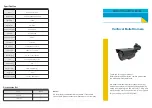
Genie Color Series-GigE Vision Camera
Operational Reference
71
Parameter
Description
IP Configuration Mode
Default is DHCP/LLA mode. Select Persistent IP if manually setting the Genie IP
address via the IP Address parameter.
IP Address
Displays the Genie IP address.
Allows setting the IP address when the mode is Persistent IP.
Network Configuration Mode
Specifies the Network Configuration Mode as either Automatic, Manual, or Optimize. In
general use Optimize mode. Some computers, especially laptops, may require manual
optimization of network parameters.
The following parameters can be modified when Manual mode is selected.
Inter-Packet Delay (in sec)
Specifies the inter-packet delay inserted by the Genie, in seconds. The range of permitted
values is 0.000000 to 0.065535. The inter-packet delay is the minimum time interval
between two successive packets. This can be increased if the NIC is unable to keep up
with packet arrivals (thus dropping packets–seen as video noise). This situation can occur
with multiple triggered cameras connected via an Ethernet switch, to one NIC.
Packet Size (in bytes)
Specifies the maximum packet size, in bytes. The range of possible values is 576 to 1500,
in increments of 4 bytes when the NIC does not support jumbo packet. The maximum is
currently 9000 bytes when jumbo packets are supported (refer to the DALSA Network
Imaging package manual to enable jumbo packets on the NIC). In most situations, use
the largest possible packet size supported by your network elements. In order to support
jumbo packets, all intermediate network elements must support them, otherwise they will
simply be silently discarded and no image data will reach the PC.
Maximum Packet Resend
Sets the percentage of packets that can be resent for each frame. This is used to ensure
the streaming data (including resends) does not exceed the Ethernet link capacity. As an
example, a system capturing at 80 MB/s can allow 25% of packet resends without
exceeding 100 MB/s (about the maximum capacity of a gigabit Ethernet link).
Inter-Packet Timeout (in sec)
Specifies the inter-packet timeout period used by the GigE server running on the host
computer (in seconds). The inter-packet timeout is the amount of time the GigE server
will wait between successive packets. If the inter-packet timeout expires, the GigE server
will issue a packet resend request to the camera.
The range of permitted values is 0.000000 to 0.65535. By default this value is greater
than (and must be greater than) the Inter-Packet Delay inserted by the Genie (described
above). Else the GigE server will force packet resends when none may be required.
Increasing the timeout period is required when a NIC has a number of Genie cameras
connected via an Ethernet switch, and packet resends can be avoided if the GigE server
delays assuming data is lost.
Image Timeout (in sec)
Specifies the timeout period for an image acquisition used by the GigE server running on
the host computer (in seconds – max=60). The Image timeout value is the amount of time
the GigE server will wait for an image to be transferred from the camera to the host
buffer memory. If the image timeout expires, the current buffer’s contents will be
incomplete and the Sapera buffer state is set to
StateOverflow
.
By default this value is greater than (and must be greater than) the time required to
receive a complete frame. The time required may depend on the number of Genie
cameras connected to the NIC and whether they transmit frames simultaneously. If the
timeout period is too short, data will be trashed and packet resend commands will be
issued. If the timeout period is too long, recovery from transmission errors may be too
slow.
Heartbeat Timeout (in Sec)
Specifies the heartbeat timeout, in seconds. The range of permitted values is 0.5 to 65, in
increments of 0.001 seconds. This is used by the camera to ensure the PC application is
still linked. If the heartbeat timeout expires, the camera will shutdown the connection to
the current application.
















































